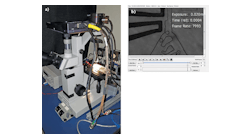Ultrahigh-speed camera aids development of new fusion process
A Specialised Imaging (Tring, England) SIMX16 ultrahigh-speed camera will help First Light Fusion (Oxford, England) study and develop its alternative approach to inertial confinement fusion based upon an aspherical cavity collapse process. Founded in 2011 as a spin-out from the University of Oxford, First Light Fusion (http://www.firstlightfusion.com) is developing a new process for achieving practical and affordable fusion energy.
Related Article
It is predicted that global energy demand will increase by 50% by 2030 thus research and development to create working fusion reactors is taking on increasing importance. First Light has discovered new implosion processes that can achieve the high temperatures and compression necessary for fusion reactions and other valuable applications. The company says its approach has the potential to dramatically shorten the timescale and cost of achieving practical and affordable fusion energy.
Hugo Doyle, a physicist at First Light Fusion, said, "We use an 8 km/s gas gun as a research tool to drive the aspherical collapse process. This allows us to reach fusion relevant temperatures and densities by taking advantage of the resulting instabilities. With interactions taking place in less than 100 nanoseconds we required a high performance optical imaging camera with exposure time at an even faster rate to remove motion blur and allow us to benchmark our predictive hydrodynamic simulations. We chose the SIMX16 camera not only because it can capture images at 1 billion frames / second but it uniquely allows us to acquire 16 images with independent control over the timing and gain for each image. This has allowed us to build a film in a single shot of several events of different brightness. This advantage is particularly important to us as our experiments have a low [repetition] rate. Previously to obtain this data we would have had to carry out 16 shots and interpolate the data—a long process. Currently we use the SIMX16 camera with a backlighting laser to image through our target and watch the shock propogate and interact with our targets. This allows us to watch the overall hydrodynamics of the process and compare with simulations. In future we plan to connect the SIMX16 to our visible light spectrometer and obtain light emission information enabling us to see the temperature of our plasma over time and space."
Capable of capturing up to 32 images at 1 billion frames per second, Specialised Imaging SIM ultrahigh-speed framing cameras are able to capture visual data from even the most fleeting of phenomena. Unlike traditional ultrafast framing cameras the optical design of SIM cameras offer the choice of up to 16 separate optical channels with excellent image quality.
SOURCE: Specialised Imaging; http://specialised-imaging.com/news-and-events
About the Author

Gail Overton
Senior Editor (2004-2020)
Gail has more than 30 years of engineering, marketing, product management, and editorial experience in the photonics and optical communications industry. Before joining the staff at Laser Focus World in 2004, she held many product management and product marketing roles in the fiber-optics industry, most notably at Hughes (El Segundo, CA), GTE Labs (Waltham, MA), Corning (Corning, NY), Photon Kinetics (Beaverton, OR), and Newport Corporation (Irvine, CA). During her marketing career, Gail published articles in WDM Solutions and Sensors magazine and traveled internationally to conduct product and sales training. Gail received her BS degree in physics, with an emphasis in optics, from San Diego State University in San Diego, CA in May 1986.

